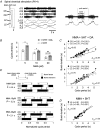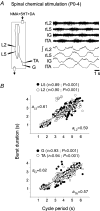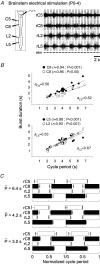Locomotor rhythmogenesis in the isolated rat spinal cord: a phase-coupled set of symmetrical flexion extension oscillators
- PMID: 17569737
- PMCID: PMC2277226
- DOI: 10.1113/jphysiol.2007.133413
Locomotor rhythmogenesis in the isolated rat spinal cord: a phase-coupled set of symmetrical flexion extension oscillators
Abstract
The temporal properties of limb motoneuron bursting underlying quadrupedal locomotion were investigated in isolated spinal cord preparations (without or with brainstem attached) taken from 0 to 4-day-old rats. When activated either with differing combinations of N-methyl-D,L-aspartate, serotonin and dopamine, or by electrical stimulation of the brainstem, the spinal cord generated episodes of fictive locomotion with a constant phase relationship between cervical and lumbar ventral root bursts. Alternation occurred between ipsi- and contra-lateral flexor and extensor motor root bursts, and the cervical and lumbar locomotor networks were always active in a diagonal coordination pattern that corresponded to fictive walking. However, unlike typical locomotion in adult animals in which extensor motoneuron bursts vary more with cycle period than flexor bursts, in the isolated neonatal cord, an increase in fictive locomotor speed was associated with a decrease in the durations of both extensor and flexor bursts, at cervical and lumbar levels. To determine whether this symmetry in flexor/extensor phase durations derived from the absence of sensory feedback that is normally provided from the limbs during intact animal locomotion, EMG recordings were made from hindlimb-attached spinal cords during drug-induced locomotor-like movements. Under these conditions, the duration of extensor muscle bursts increased with cycle period, while flexor burst durations now tended to remain constant. Moreover, after a complete dorsal rhizotomy, this extensor dominant pattern was replaced by flexor and extensor muscle bursts of similar duration. In vivo and in vitro experiments were also conducted on older postnatal (P10-12) rats at an age when body-supported adult-like locomotion occurs. Here again, characteristic extensor-dominated burst patterns observed during intact treadmill locomotion were replaced by symmetrical patterns during fictive locomotion expressed by the chemically activated isolated spinal cord, further indicating that sensory inputs are normally responsible for imposing extensor biasing on otherwise symmetrically alternating extensor/flexor oscillators.
Figures






Similar articles
-
Cervicolumbar coordination in mammalian quadrupedal locomotion: role of spinal thoracic circuitry and limb sensory inputs.J Neurosci. 2012 Jan 18;32(3):953-65. doi: 10.1523/JNEUROSCI.4640-11.2012. J Neurosci. 2012. PMID: 22262893 Free PMC article.
-
Fictive locomotor patterns generated by tetraethylammonium application to the neonatal rat spinal cord in vitro.Neuroscience. 2006;137(2):659-70. doi: 10.1016/j.neuroscience.2005.09.025. Epub 2005 Nov 14. Neuroscience. 2006. PMID: 16289841
-
Chapter 2--the spinal generation of phases and cycle duration.Prog Brain Res. 2011;188:15-29. doi: 10.1016/B978-0-444-53825-3.00007-3. Prog Brain Res. 2011. PMID: 21333800 Review.
-
Electromyographic activity patterns of ankle flexor and extensor muscles during spontaneous and L-DOPA-induced locomotion in freely moving neonatal rats.Exp Neurol. 2002 Feb;173(2):256-65. doi: 10.1006/exnr.2001.7791. Exp Neurol. 2002. PMID: 11822889
-
Spinal motor patterns in the turtle.Ann N Y Acad Sci. 1998 Nov 16;860:142-54. doi: 10.1111/j.1749-6632.1998.tb09045.x. Ann N Y Acad Sci. 1998. PMID: 9928308 Review.
Cited by
-
Heterozygous Dcc Mutant Mice Have a Subtle Locomotor Phenotype.eNeuro. 2022 Mar 8;9(2):ENEURO.0216-18.2021. doi: 10.1523/ENEURO.0216-18.2021. Print 2022 Mar-Apr. eNeuro. 2022. PMID: 35115383 Free PMC article.
-
Acquisition of bipedal locomotion in a neuromusculoskeletal model with unilateral transtibial amputation.Front Bioeng Biotechnol. 2023 Mar 1;11:1130353. doi: 10.3389/fbioe.2023.1130353. eCollection 2023. Front Bioeng Biotechnol. 2023. PMID: 36937747 Free PMC article.
-
State-dependent rhythmogenesis and frequency control in a half-center locomotor CPG.J Neurophysiol. 2018 Jan 1;119(1):96-117. doi: 10.1152/jn.00550.2017. Epub 2017 Oct 4. J Neurophysiol. 2018. PMID: 28978767 Free PMC article.
-
V1 interneurons regulate the pattern and frequency of locomotor-like activity in the neonatal mouse spinal cord.PLoS Biol. 2019 Sep 12;17(9):e3000447. doi: 10.1371/journal.pbio.3000447. eCollection 2019 Sep. PLoS Biol. 2019. PMID: 31513565 Free PMC article.
-
Rat locomotor spinal circuits in vitro are activated by electrical stimulation with noisy waveforms sampled from human gait.Physiol Rep. 2013 Jul;1(2):e00025. doi: 10.1002/phy2.25. Epub 2013 Jul 8. Physiol Rep. 2013. PMID: 24303112 Free PMC article.
References
-
- Atsuta Y, Garcia-Rill E, Skinner RD. Electrically induced locomotion in the in vitro brainstem–spinal cord preparation. Brain Res. 1988;470:309–312. - PubMed
-
- Baker LL, Chandler SH, Goldberg LJ. l-dopa-induced locomotor-like activity in ankle flexor and extensor nerves of chronic and acute spinal cats. Exp Neurol. 1984;86:515–526. - PubMed
-
- Ballion B, Morin D, Viala D. Forelimb locomotor generators and quadrupedal locomotion in the neonatal rat. Eur J Neurosci. 2001;14:1727–1738. - PubMed
-
- Barbeau H, Rossignol S. Recovery of locomotion after chronic spinalization in the adult cat. Brain Res. 1987;412:84–95. - PubMed
Publication types
MeSH terms
Substances
LinkOut - more resources
Full Text Sources

